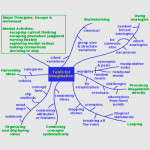
TPS (Toyota Production System) Training
In a Nutshell
The purpose of this blog to give you an idea of how people are trained in the lean Thinking Methodology at Toyota (TPS training). Why? Because it seems to us that many companies are missing a fundamental pillar when it comes to the lean implementation: their people. Without a profound understanding of the underlying lean philosophy, concept and tools, without being thoroughly trained on the job, without knowing how to approach the problem solving process, the effort of becoming Lean becomes a waste—futile.
It took Toyota over 30 years to develop what we call today TPS (Toyota Production System). Organizations cannot just copy and paste the tools they developed and call themselves lean, for may have tried and few succeed. The Reason is simple: A lean environment requires a different approach to performance measurement, a different approach to to management and leadership, and a different approach to organizational structure.
Toyota Production System
So, how does Toyota conduct TPS Training their employees in the TPS?
- Train the trainer: Create the lean leadership organization.
- Selected people go through intensive TPS training at Toyota’s consulting division and become TPS trainers or mentors.
- Then, the TPS trainers train the managers and supervisors the lean principles and tools and also their jobs and responsibilities.
- Develop the managers and the leaders: They are not only responsible for the safety, quality, delivery, and cost but also for ensuring TPS training and developing their employees and for the integrity of TPS in the workplace. Over time, they are trained in the following: the role of a supervisors, job instructions, standardized work, principles of JIT, problem solving techniques, kaizen.
- Orientation: The new employees go through an orientation period (a week) where they learn in detail about TPS. The TPS training is done in a classroom environment. They learn about: production system, kanban, team work, kaizen, safety, attendance, housekeeping, quality principles, competition in the auto industry, etc.Then, every topic is followed by a practical exercise on the shop floor or office environment, depending on the position of the new employee. This is done to demonstrate that the participants learned what they were supposed to learn.
- Apprenticeship: Managers and supervisors train the new employee on the job, following the orientation. Every employee works on the job he/she was hired for alongside the trainer or the group leader. For a period of up to two months, the new employee has this trainer assigned to ensure that the job is performed exactly as intended, while gaining the deep knowledge, of the basic TPS principles (team building, takt time, one-piece flow, kanban and pull, cost drivers, jidoka, problem solving methodologies, seven types of waste, kaizen, the three rules of Just-In-time (produce what the customer needs, in the right quantity, at the right time). So, you see the huge importance placed upon training at all levels, on coaching and mentoring and on discipline at all levels.
Conclusions
The employees get their TPS training from their managers/supervisors/mentors and form on the job training and not from books or by attending seminars. The knowledge is transferred continuously. Toyota creates a culture of lean leadership, developing their own lean leaders, as opposed to using external help/consultants. These lean leaders then teach the managers and supervisors not only the lean tools but their roles and responsibilities.
Lean cannot be implemented by one individual but by creating an entire workforce that performs their job in a lean manner. All the managers and supervisors are responsible and accountable for the lean implementation. The fact that several Toyota plants in North America outperformed their sister plants in Japan tells us that the lack of success in the lean implementation cannot be blamed on the cultural differences as some people claim.
It is, rather, a result of not engaging the whole workforce in a thorough lean and on-the-job training (similar to TPS Training), of not having a leadership team knowledgeable in lean principles and tools and not understanding their roles and responsibilities and, lastly, in not having own lean leaders to drive the lean transformation at all levels. Of course, there is another prerequisite: having a vision created at the highest level in the company and following that vision as a true North.
If you are looking to develop your own production system, we can help you with materials to start your own version of TPS Training.

